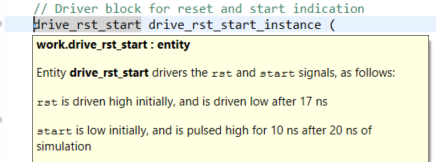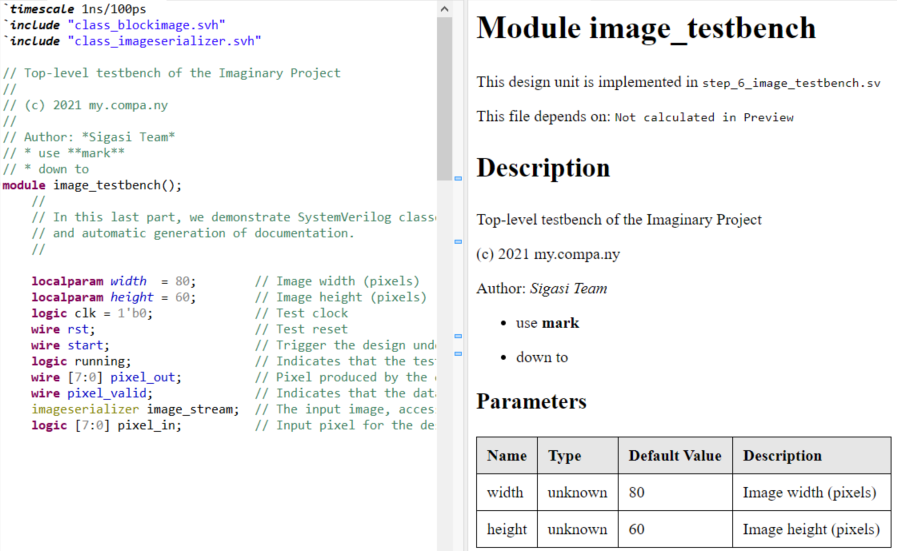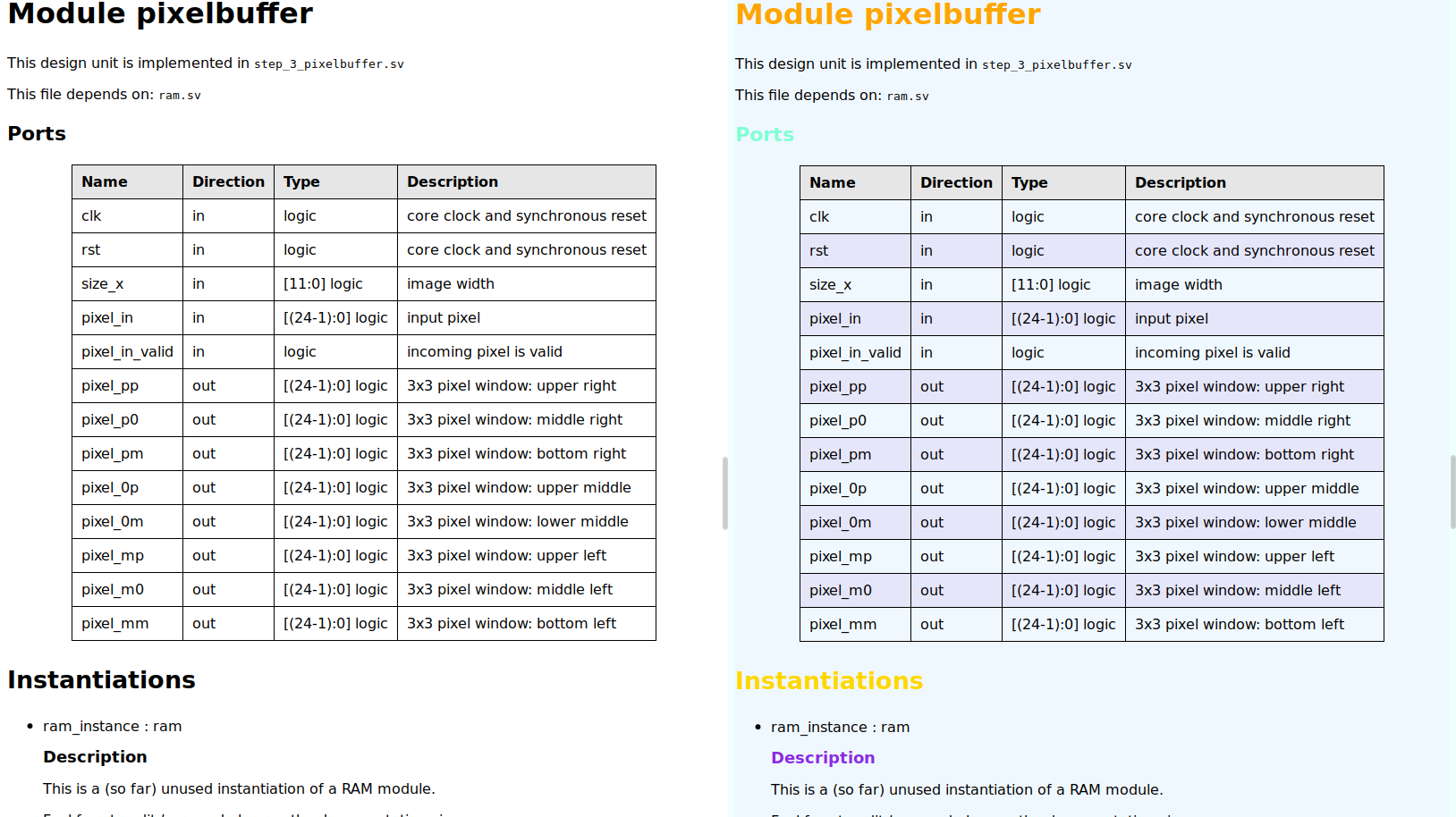This article discusses documentation of Hardware Description Language (HDL) code, and how Sigasi Visual HDL (SVH) can help with that. Designers (and their managers) generally agree that well documented code is important. In practice, actually documenting code, documenting code well, and keeping documentation up to date doesn’t always happen. The excuse is often time, as in we didn’t want to spend extra time or we didn’t even have time to write documentation (but a few months later we spent much more time tracking that one bug while reverse engineering our own code…) So before getting into the how of documentation, we’ll first revisit why good documentation is important.
The importance of well documented HDL code
Documentation is a source of information about your HDL code. Adding documentation makes code easier to understand. While the person writing the code may have perfect understanding of their code, it is highly likely that more people will sooner or later need to understand the code. And in as little as a few weeks or months, even the author of the code may well have forgotten some important details. The extra information in the documentation is helpful for a number of things:
- Preservation and transfer of knowledge: documentation helps to understand the code. Colleagues may need to work with your design. Customers may want to integrate your IP block. And after a while, you may want the extra information to remember the ins and outs of your own design.
- Code quality: writing documentation forces the designer to think of their design in two languages, namely the computer language or the HDL in this case, and a natural language, often English. Doing so reduces the risk of design flaws, because the designer is more likely to spot a problem. And if that didn’t work, well documented code is also easier to review, which is another contribution to code quality. Hint for reviewers: review also documentation!
- Maintainability and debuggability: if code is easy to understand, it is also easier to maintain and debug.
Good code is self-documenting, now what?
Good documentation is important, but there’s a saying that good code is (or should be) self-documenting. So how about that? How can code be self-documenting, and is that enough? Self-documenting code is indeed a Good Thing. With this term we denote the use of programming techniques to make code maximally understandable without further explanation. This includes:
- Using meaningful names for entities, architectures, modules, functions, ports, signals, variables, types…
- Declaring and using constants (again, with a meaningful name) instead of using the constant value directly throughout the code.
- Using code constructs that are easy to read, even if they are more verbose.
Writing your code this way makes it easy to understand what the code does. It does not document why the code does what it does, nor does it give high-level information of how to use the code. This is where further documentation is needed.
Where shall we put the documentation?
Documentation can be added to code either in a separate document, or as comments in the code. The latter approach is particularly interesting in many cases, because:
- documentation is found where it’s needed, namely with the documented code, and
- programmers are more likely to keep documentation up to date if the documentation is with the code rather than somewhere else.
In some cases, a separate document is useful too. A customer using your IP block, for example, may need the information about your IP block but they don’t get access to the code. Or you may want to collect all the documentation in one place, which is easier to read than when it’s mixed up with the code. Fortunately, tools (like Sigasi Visual HDL) exist to extract documentation from comments in code, so you won’t need to write the documentation twice.
How to write good comments
Ideally, what we want is the best documentation with the least possible amount of effort. The good news is that, to some extent, these concerns are not each other’s opposite. A few guidelines will help you optimize your documentation effort.
- Write self-documenting code. Anything that is clear from reading the code doesn’t need further documentation. Using meaningful names, for example, will help a lot. What do you think of these examples?
tc = tk - 273; -- er, what? temperature_celcius = temperature_kelvin - kelvin_celcius_offset;
- Don’t state the obvious. What your code does should be clear from the code itself, particularly if your code is self-documenting, so don’t repeat what the code does in comments. Not adding comments where they aren’t needed is a double win: you don’t need to write the comments and you don’t need to keep them up to date.
-- convert kelvin to celcius by subtracting the offset between the two
temperature_celcius := temperature_kelvin - kelvin_celcius_offset;Document the why rather than the what. This is where comments become useful, as you actually add information which is not in the code. In HDL, this is even more important than in typical software development languages. Register Transfer Level (RTL) code contains a mix of functionality (what does the circuit do?), architecture (what does the circuit look like?) and timing (when does each operation take place?). It is estimated that only about 20% of RTL code describes functionality. Good documentation is essential to understand the code well.
Document what to generally expect as well as corner cases. It is good practice to add a high-level description to larger parts of the design, e.g. functions, VHDL entities, Verilog modules, SystemVerilog classes and methods … The description should include the problem(s) which the code solves, what data are consumed and produced, and potentially the algorithms used to process the data. Also mention corner cases and limitations of the code.
Documentation in SVH
SVH, the integrated development environment for digital chip design, helps you write and maintain documentation for your HDL projects. In the next paragraphs, we’ll highlight how to write documentation, and how to view it and export it as a separate document.
Documenting your code in SVH
SVH Makes documenting easy. It associates comments with the code. The only requirement is that comments are in the right place, usually either on the line(s) before the code they refer to, or on the same line. For example:
// A general description of my_module goes here.
// These comment lines are associated
// with module my_module
module my_module();
logic clk = 1'b0; // Test clock (comment associated with logic clk)
wire rst; // Test reset (comment associated with wire rst)
No particular syntax for the comments is required, only the placement of comments determines the association. Details are discussed in the SVH manual.
Using the documentation while writing code
As soon as these comments are written, SVH will pick them up and show them when appropriate, e.g. in hovers. When you place your mouse pointer over an item which has documentation associated, the documentation will be displayed in a pop-up. Consider this entity:
-- Entity **drive_rst_start** drivers the `rst` and `start` signals, as follows:
--
-- `rst` is driven high initially, and is driven low after 17 ns
--
-- `start` is low initially, and is pulsed high for 10 ns after 20 ns of simulation
entity drive_rst_start is
port(
rst : out std_logic;
start : out std_logic
);
end entity drive_rst_start;
Now we’ll instantiate this entity somewhere else. Wait, what did it do? Place the mouse pointer over the entity’s name and there is the documentation!

These hovers also work with signals, variables, functions, and any item that may have comments associated with it.
Note that some of the text is formatted differently,
e.g. drive_rst_start is bold, and rst and start are verbatim.
Comments may be formatted using
markdown,
as we’ve demonstrated in the example. Bold, italics, titles, bullets,
coloured fonts, it’s all possible.
The documentation view
From a design file in the Sigasi editor, you can open the Documentation view: right-click in the editor and select Show In > Documentation. The documentation is opened in a separate window as shown below. This view shows the documentation of a single file: design units, tables with ports and parameters, instances, etc.

The documentation view gets updated as you type in the editor, no need to save your code to see the effect on the documentation.
Exporting documentation as HTML
A further step is to export the documentation as an HTML file. You can choose to export the documentation of either a particular hierarchy (i.e. a module, entity or architecture and all its submodules) or all of your project. In SVH, go to Project > Export > Documentation… for this functionality. Note that exporting documentation requires an Enterprise license.
The result is a single, fully hyperlinked HTML file with the documentation of the selected hierarchy or project. In addition to the documentation view, exported documentation also includes block diagrams and state machine diagrams. In the next paragraph, we’ll discuss how you can modify the style of the generated documentation to better match your requirements. We’re also planning a follow-up article on how you can do even more fancy stuff with the generated document.
Tweaking HTML using CSS
Since Sigasi Studio 4.12 you can customize the CSS
used in the exported HTML documentation.
All you need to do is add a sigasi-doc.css (example) file in the root of your project.
The CSS from this file will be inserted after the styling that ’s added by default.
The specifications can be found in our
manual.
Conclusion
If you’ve read the article to this point, you must be convinced that good documentation is essential in HDL design. We have also presented some good documentation practices. SVH can help you with documentation. It is very easy to get started, so I invite you to try this out yourself.
See also
- Customize documentation from Sigasi Visual HDL using the Document Object Model (knowledge)
- Customizing documentation from Sigasi Visual HDL: easier than you think (knowledge)
- How to set up the UVM Library in Sigasi Visual HDL (knowledge)
- How to set up the UVVM Library in Sigasi Visual HDL (knowledge)
- Documentation features for large designs in Sigasi Visual HDL (knowledge)
